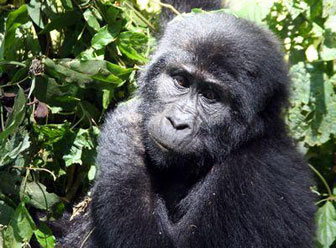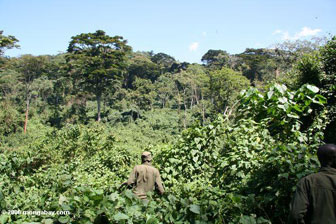Rare gorillas slaughtered in mass killing
Rare gorillas slaughtered in mass killing
mongabay.com
July 24, 2007
At least four critically endangered gorillas have been killed in Democratic Republic of Congo’s Virunga National Park. National Geographic News reports they were shot “execution-style”. Illegal charcoal harvesters are leading suspects in the slaying. Two other gorillas are missing and feared dead.
Park staff were stunned by the killing.
“We are deeply shocked,” wrote Paulin Ngobobo, A Virunga ranger, wrote on his Gorilla Protection blog for Wildlife Direct. “There are no words for what we are feeling.”
Wildlife Direct told National Geographic News they heard gun shots from inside the reserve around 8 p.m. on Saturday night. In the morning, rangers located the first three bodies.

Juvenile gorilla in Bwindi (top) and a wildlife guide searching for gorillas in Bwindi (bottom). Photos by Rhett A. Butler |
“The gorillas were all quite close together. They had all been shot,” National Geographic News quoted Emmanuel de Merode, director of WildlifeDirect, as saying.
Senkekwe, the silverback which headed the so-called Rugendo family of 12 gorillas, was found dead this morning.
The killings follow a similar shooting of two silverback gorillas from the same family group earlier this year. De Merode said that charcoal traffickers, who supply the nearby city of Goma, with were likely to blame.
Virguna National Park park, which sits near the border with Rwanda, supports roughly 360 of the world’s remaining 700 mountain gorillas. Another 340 mountain gorillas are found in neighboring Uganda’s Bwindi Impenetrable Forest National Park.
Gorillas haven’t been only victims of strife in the region. WildlifeDirect estimates that since the beginning of the conflict in eastern Congo nearly a decade ago, some 150 park rangers have been killed on active duty.
Conservationists say gorillas can bring benefits to the local economy. In Uganda’s Bwindi, well-trained guides lead small and carefully supervised groups of tourists who pay more than $300 each for a permit to see the gorillas. The efforts have provided some compensation for communities around the park who have had to give up their right to cut timber and harvest game from the protected forest.
